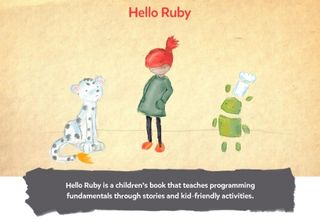Why you should use stories to teach coding
Coder and children's author Linda Liukas tells Martin Cooper why stories are the perfect medium to teach programming.
Hello! Why don't you introduce yourself?
My name is Linda Liukas. I'm originally from Finland and split my time between Helsinki and New York. I love Muji, Zelda Fitzgerald and Moomins.
Tell us about Rails Girls. How did it come about, and why?
Rails Girls is a global grassroots movement to encourage more women to get their first experience in software craftsmanship. It's a one-weekend event during which total beginners will be helped through building a web application from concept to code. The event was born out of my own need. To date, Rails Girls has been organised in over 160 cities, always non-profit, by the local Ruby community.
What's the secret of getting kids involved in coding?
For me, programming has always been about creativity, expression and practical application. There's always going to be kids that will become programmers who work on complicated algorithms, but for many, code is just another tool to use in a world that is more and more run by software.
I like your expression "hands on, minds on working". Can you explain it to us, please?
Our kids should learn to bend, join, break and combine code in a way it wasn't designed to. I love learning by doing and then afterwards understanding the larger context of a problem, and that's what I advocate in my own programming pedagogy. I'm fascinated by the spiral learning theory where you introduce a topic, touch on it for a short time and then move on. The idea is that a subject isn't learned the first time around and the kids can pick up more information the second time. This is the whole thinking behind Hello Ruby.
Tell us more about Hello Ruby.
I believe stories are the most formative force of our childhood. The stories we read growing up affect the way we perceive the world as we grow up. For some reason narratives haven't been used as part of technology education. Hello Ruby is my attempt at combining software and storytelling into something that will make kids see the magical world of technology as well as learn programming concepts.

How did the idea come about?
I was teaching myself programming three years ago and started doodling the Ruby character in my notes. Whenever I ran into a problem, like what is garbage collection or how does object oriented programming work, I'd try to imagine how little Ruby would explain it. The imaginative viewpoint of a small girl started to pop up everywhere in the technology world and I knew I had a book in my hands.
Where is the true value in code? (I love your quote, "Code's not about ones and noughts. Value of code is in the people.")
I think technology is profoundly human and a lot of non-technical people don't see this aspect of code. Computers don't write code, it's people. Computers don't design programming languages, it's people again. Platforms like GitHub give a glimpse of how social creating software is, but there's still a long way to show all the creativity, compassion and culture that exists in programming communities. As Joi Ito put it, "Internet is not a technology, it's a belief system."
Is it true that you built your first website as a love note to Al Gore?
Yes! I was 13 years old and had a huge crush on the then vice president of US. I had all of this passion and excitement and energy, so I decided to build a website for him in Finnish and needed to learn HTML/CSS for that. The site is luckily not online anymore, but I was very proud of the iFrames, colour scheme and the manually created thumbnail pictures.
Words: Martin Cooper
This article originally appeared in net magazine issue 253.

Thank you for reading 5 articles this month* Join now for unlimited access
Enjoy your first month for just £1 / $1 / €1
*Read 5 free articles per month without a subscription

Join now for unlimited access
Try first month for just £1 / $1 / €1
Get the Creative Bloq Newsletter
Daily design news, reviews, how-tos and more, as picked by the editors.
The Creative Bloq team is made up of a group of design fans, and has changed and evolved since Creative Bloq began back in 2012. The current website team consists of eight full-time members of staff: Editor Georgia Coggan, Deputy Editor Rosie Hilder, Ecommerce Editor Beren Neale, Senior News Editor Daniel Piper, Editor, Digital Art and 3D Ian Dean, Tech Reviews Editor Erlingur Einarsson, Ecommerce Writer Beth Nicholls and Staff Writer Natalie Fear, as well as a roster of freelancers from around the world. The ImagineFX magazine team also pitch in, ensuring that content from leading digital art publication ImagineFX is represented on Creative Bloq.
